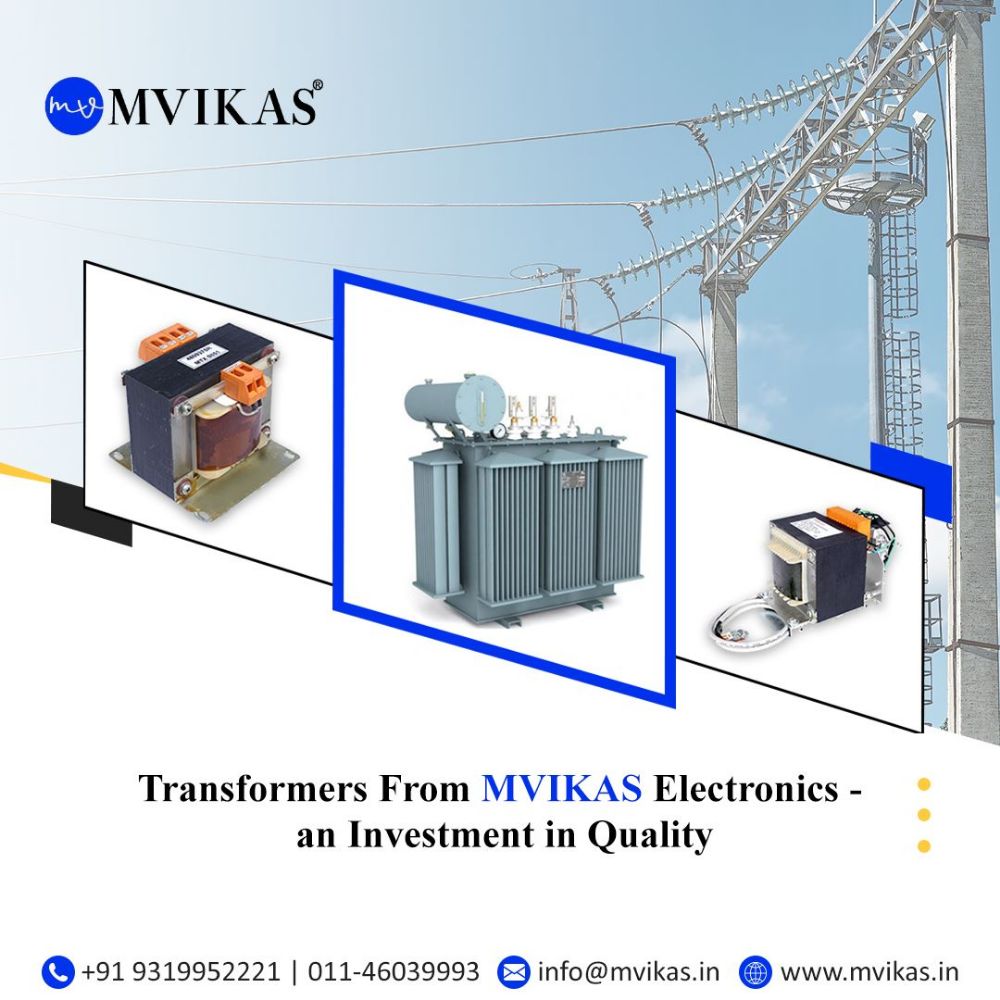Reachable at 9560662883  011-46039993 (Ext. 21 to 32) (10am - 06pm)
011-46039993 (Ext. 21 to 32) (10am - 06pm)
Transformers from MVIKAS Electronics – an Investment in Quality

A transformer is a device that transfers electric energy from one alternating-current circuit to another, either increasing (stepping up) or decreasing (stepping down) the voltage. Transformers may be used to raise or reduce the voltage, referred to as stepping up or down. Transformers are made of two wire coils wrapped around a metal core, each with hundreds or thousands of turns.
Kinds of Transformers
There are two kinds of Transformers:
- Step-up Transformer
- Step-down Transformer
Step-up Transformer
A step-up transformer is a transformer used to boost the voltage from primary to secondary. While this is done to make it appropriate for general use, some equipment, such as electrical motors, microwaves, and X-ray machines, require a high voltage to start. A step-up transformer converts the present power supply to the necessary voltage.
Step-down Transformer
A step-down transformer is a transformer that reduces the voltage from primary to secondary. Step-down transformers can be used in various applications, the most common of which are primary adapters and chargers for mobile phones and stereos, transmission lines, welding machines, inverters, TVs, and voltage stabilizers.
How to Choose the Proper Transformer?
Determine the input and output voltages, frequency, and current to pick the appropriate transformer. The greater the frequency, the faster the voltage changes. The greater the stream, the greater the amount of heat created. Other formulae are applicable. Many designs are industry standards, with cross-references to component numbers from various manufacturers. If you are establishing a new application and want to know how to choose a transformer, here are the factors you should consider.
- Voltage(s) input and output, frequency, and current
Determine the input and output voltages, frequency, and current to pick the appropriate transformer. The greater the frequency, the faster the voltage changes. The greater the stream, the greater the amount of heat created. Other formulae are applicable.
- Requirements for Safety Agency Certification
UL, CSA, and CE requirements differ depending on the application. Medical items, for example, have quite different requirements than office ones. Determine the specific agency criteria you are attempting to achieve.
- Determine mounting configuration
The most common options are PC mount or Chassis mount. However, our application experts may provide various choices to match your needs.
- The available space is sometimes quite restricted
If this is the case in your arrangement, be prepared to set height, length, and width constraints. Knowing the size constraints will aid in the proper transformer selection procedure.
Transformers' Significance in the Industrial Base Sector
However, because industries deal with large equipment, they must ensure a precise, suitable, safe, and risk-free power supply to commit consistent power difficulties. We will now discuss the significance of transformers in the industrial sector. It contributes to the safety and efficiency of power networks by keeping voltage levels as high and low as necessary. It curates various industrial uses for power distribution and control across great distances.
The importance of transformers in industries is as follows:
The industrial sector must ensure suitable, safe, and careful power supply consumption to minimize unneeded power concerns.
- Automobile Industry
Customized smart transformers are currently being created to charge the batteries of many electric vehicles simultaneously. They can check voltage levels and help you save money.
- Electromechanical Industry
In the electrochemical sector, electroplating is an ordinary operation. Different elements, such as copper, zinc, aluminum, chlorine, and so on, are electrolyzed - rectifier transformers play a significant part in such operations.
- Steel Manufacturing Industry
Specific specialized transformers are employed here to provide a safe, high-voltage supply. They are well-designed to withstand a steel furnace's dielectric, mechanical, and thermal stresses.
They are also employed in various industries, including aerospace, military, biochemical and biomedical, data processing, communications, and manufacturing.
Considerations to Make Before Purchasing a Transformer
When purchasing a transformer, various considerations must be made.
- Voltage
Transformers are mainly used to modify the primary power supply voltage to satisfy the necessary needs. Variable transformers can give different voltages; nonetheless, one crucial aspect to examine when selecting transformers is the voltage of the primary power source. The transformer's input voltage is determined by the primary power source, while the demand determines the output voltage.
- Power supply phases
To begin, determine whether you require a single-phase or three-phase transformer. Simple equipment and domestic appliances require single-phase transformers, whereas commercial and industrial uses require three-phase transformers.
- Frequency
Transformers may also change the frequency of the power supply. Frequency is especially significant when the equipment is in a foreign nation with a different power supply frequency.
- KVA Requirement
Before selecting a transformer, it is critical to consider the load needs. A larger capacity transformer is chosen to maintain heavy loads.
- Location
Where do You Intend to Put the Transformer?
Is the transformer going to be put inside or outside? Is the transformer going to be near chemicals or other potentially harmful substances? Consider all this. If the transformer is to be positioned outside or near such dangerous chemicals, it must be mainly constructed to resist such extreme circumstances.
MVIKAS's experienced design engineers are ready to discuss everything with you to assist you in choosing the ideal product for your application, whether a traditional catalogue design or a bespoke design. If you want a bespoke design, they will employ components from the normal range to assure easy availability and low cost.

Leave your comment